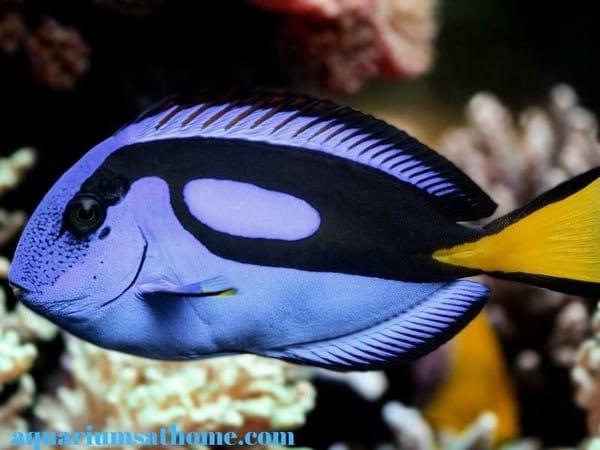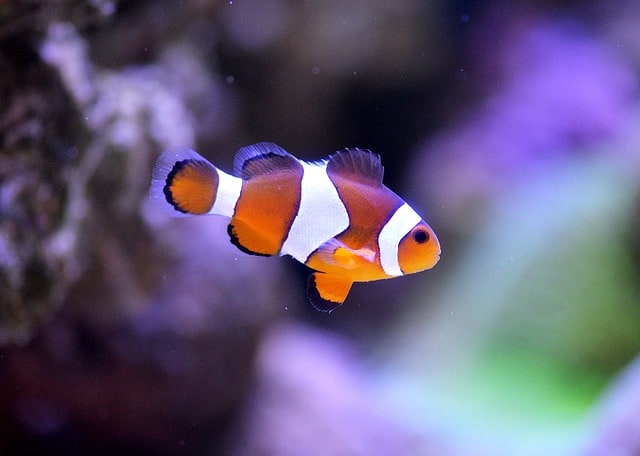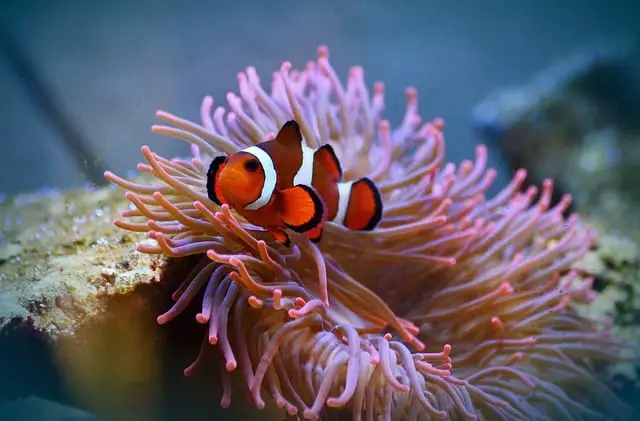When you think of blue tangs, the image that often comes to mind is that of Dory – the lovable, yet absent-minded fish voiced by Ellen DeGeneres in the Disney/Pixar classic cartoon Finding Nemo. If you have a saltwater tank, you may be tempted to add a blue tang (or two) to your aquarium. This ultimately begs the question: are blue tangs difficult to keep?
In general, blue tangs aren’t difficult to keep, provided their aquatic environment is conducive to their needs. Under the right conditions – which include a large tank, highly-oxygenated water, and plenty of ‘green’ food to eat – blue tangs can live anywhere from 8 to 12 years in captivity. As with most other saltwater fish, blue tangs are recommended for advanced aquarium hobbyists rather than beginners.
Now that you know blue tangs aren’t hard to maintain if properly cared for, let’s dive deeper into this topic together. We’ll learn what size tank is they require, what type of water conditions they prefer, and what kinds of foods they eat. We’ll also discuss whether blue tangs are aggressive or not and which fish make the best tankmates.
So, if you’re ready to learn more about how to successfully keep blue tang fish in an aquarium, then let’s get to it!
Are Blue Tangs Good for Beginners?
Though not difficult to keep under the right aquatic conditions, blue tangs are generally recommended for experienced aquarium hobbyists. Saltwater tanks (and the fish that inhabit them) tend to be more expensive to purchase and more work to sustain. Be prepared to spend anywhere from $20 to $80 on a single blue tang and that’s just for the fish alone – food and tank set-up/maintenance cost extra!
My personal recommendation would be to wait until you have at least 1 year of salt water tank maintenance experience before considering purchasing blue tangs.
What is the Lifespan of a Blue Tang?
In the wild, blue tangs can live upwards of 30 years. In captivity, however, they’re lifespan is significantly less – anywhere from 8 to 20 years, depending on the conditions of their aquatic surroundings. Life in an aquarium makes blue tangs much more susceptible to disease, especially ‘ick’. Therefore, it’s imperative that you keep the tank clean and healthy for the well-being and longevity of your blue tang fish.
How Big of a Tank Do I Need for a Blue Tang?
Blue tangs require a long, extra-large tank – at least 6-feet in length and holding 100-gallons of water or more, depending on how many fish you have! This fish is highly active and likes to swim horizontally rather than vertically. Adults can reach lengths of 5 to 15 inches and weigh up to 22 ounces, hence the need for a big aquatic environment.
What Type of Water Conditions Do Blue Tangs Prefer?
Blue tangs are a species of marine fish and as such, require a saltwater tank with a temperature of 73 to 80 degrees Fahrenheit. The pH should range between 8.1 and 8.4 with a salinity of around 1.025. They can be finicky when it comes to water conditions, which is why they’re often recommended for more advanced aquarium hobbyists.
What Equipment is Necessary for a Tank with Blue Tangs?
Blue tangs need a well-oxygenated environment. Therefore, a filter, an air pump, and a protein skimmer are required. A sump set-up greatly improves aeration and is highly recommended for this species. As a type of marine fish, they prefer warmer water, so a heater and an aquarium light are necessary as well. You also need a water testing kit, water conditioner, aquarium salt, a siphon, and an algae scrapper.
What Do Blue Tangs Like in Their Tank?
Plenty of live rock is a prerequisite for any blue tang aquarium. They feed off nori or marine algae so providing them with ample opportunities for grazing in-between meals is a must! As this fish can be skittish (and will even ‘play dead’) – especially if alone in a tank with other bigger, more aggressive fish – a reef tank set-up with plenty of hiding places for cover is recommended.

What Do Blue Tangs Eat?
Blue tangs are omnivorous but prefer to eat greens like seaweed and plankton. They’ll also dine on meaty foods like krill and brine shrimp. Nori is a staple in their diet – and they need a lot of it daily! You can purchase nori-based foods in flake and sheet form online or at your local fish store. This species also likes to graze and will nibble on the algae that grows naturally on live rocks in their tanks.
Are Blue Tangs Aggressive?
In a big enough tank with plenty of room to swim and forage, blue tangs are usually peaceful towards their fellow tankmates. They can, however, become aggressive towards other surgeonfish, especially those of like size, shape, and appearance. For this reason, it’s best to keep just two (one male and one female) tangs in the same tank. If you have a very large 200-gallon tank, then you can keep up to four.
What Fish Can You Keep with Blue Tangs?
Blue tangs have a calm disposition and are non-territorial in nature – unless overcrowded or kept in too small of a tank, that is. If introduced to the tank at the same time, different species of tangs can co-exist peacefully so long as they don’t look too similar. For example, blue tangs can live with yellow tangs but not powder blue tangs.
Best tankmates for blue tangs include other docile fish including saltwater angels, butterflies, cardinals, clownfish, chromis, damsels, filefish, gobies, grammas, and wrasses. If you want to keep multiple tangs, then you must be willing to upsize your tank. As well, the tank should have plenty of hiding places for cover as well as a few saltwater plants like green finger or spaghetti algae, seagrass, and mermaid’s fan.
Why You Wouldn’t Buy a Blue Tang?
If you’re a beginner aquarium hobbyist or familiar with freshwater as opposed to saltwater tanks, then you shouldn’t buy a blue tang until you have more experience and/or do plenty of research in advance. This species, though not difficult to keep under the right circumstances, is prone to a parasitic disease known as ‘ick’ which can have a detrimental effect on other tank inhabitants if not eradicated promptly.
As well, recent studies on wild-caught blue tangs show an increase likelihood of exposure to cyanide poisoning. Unlike other saltwater fish that can be captive-bred, blue tangs can only breed in the wild – despite over a decade of trying to reproduce them successfully in captivity by aquaculture scientists. High amounts of cyanide in a limited space like an aquarium often results in spontaneous fish death.
Conclusion
To conclude, taking care of blue tangs is straightforward and not that difficult – for the more experienced aquarium hobbyist, that is. If their aquatic environment is healthy, safe, and conducive to their physical needs, this species can live up to 12 years in captivity. All they really need to survive (and thrive) is a long and large tank, clean, well-oxygenated water, and lots of plant-based foods to eat.
I trust this article has answered your questions pertaining to blue tang fish and how to maintain them. Thanks for reading and good luck with your aquarium hobby!
Related Posts
Which is Better a Freshwater or Saltwater Aquarium?
Why are Saltwater Fish More Colorful than Freshwater Fish?
Why are Damselfish so Aggressive? (Which One Bites?)
Flame Hawkfish Care and Tank Setup (Behavior, Tank Mates, Breeding)






